RBA Annual Conference – 1995 Measuring Productivity in the Australian Banking Sector Alan Oster and Lawrence Antioch[*]
1. Introduction
The potential benefits of increased productivity in intermediate sectors – such as banking and finance – can be substantial, given the impact of their services on resource allocation and competitiveness in the broader economy. No doubt, these considerations were high in the minds of policy makers in the 1980s when significant deregulation of the Australian financial sector was undertaken. And yet, despite more than a decade of reform, the level of measured labour productivity in the finance sector fell over the course of the last business cycle. But the specific nature of this sector, including its increasingly service-oriented focus, the non-market value of its output, and the role of rapid technological innovation, has complicated the analysis of its productivity performance.
Against that background, this paper briefly discusses some of the conceptual issues peculiar to measuring productivity in the finance sector. It examines a range of productivity indicators for the banking component of the sector, with specific reference to the National Australia Bank (NAB). An examination of these indicators at the enterprise level may thereby shed some light on actual productivity performance in the banking and finance sector since the early 1980s.
2. Measuring Productivity in the Finance Sector – The Conceptual Issues
The conceptual and empirical problems that plague the measurement of physical output in most service industries are particularly acute in the banking sector, where there is no clear consensus on an appropriate definition of output (Triplett 1990). For example, since banks engage in intermediation, are their deposits to be measured as an input or an output? The most common response to this problem is to examine indicators of productivity in the banking sector that are generally derived from accounting data. For example, in the 1989/90 Commonwealth Government Budget Papers, the Commonwealth Treasury presented the decline in the ratio of operating costs (excluding provisions for bad debts) to average assets as evidence that productivity improvements in the banking industry had indeed occurred. Other frequently-used accounting measures include the ratios of operating income to costs or staff expenses.
The rationale for these accounting indicators is that productivity improvements, including the productivity of non-labour inputs, should mean that a lower level of costs or employment is required to manage a given level of assets, or to produce a given level of income. However, these ratios can be interpreted more correctly as measuring the banks' efficiency target rather than directly measuring their productivity. Nonetheless, such measures of efficiency are the most commonly-examined indicators of productivity in banking. Consequently, efficiency concepts will be used to structure the main points of analysis in this paper.
Concepts of efficiency relate to how well a bank employs its resources relative to the existing production possibilities frontier (or, in other words, relative to current ‘best practice’) – how an institution simultaneously minimises costs and maximises revenue, based on an existing level of production technology. The analysis of bank efficiency, therefore, relies on intra-sector comparisons, involves both technological and relative pricing aspects, and has partial indicator value for analysing productivity performance. The concept of productivity, on the other hand, refers to the performance of the sector as a whole and effectively combines changes in efficiency and technological advances in an average measure. Figure 1 organises aspects of efficiency measures in order to gain a perspective on banks' productivity. This paper will attempt to exploit some of these channels in its analysis.
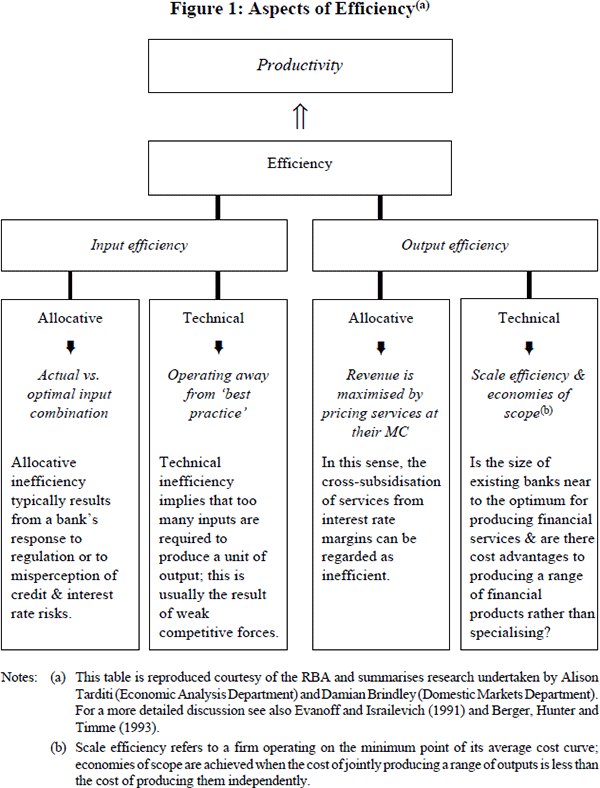
3. Gauging Productivity in the Banking Sector – Some Measurement Issues
3.1 Input Efficiency
These first measures concentrate on the degree of efficiency with which banks combine their inputs to produce a given level of output at minimum expense. Since the mid 1980s, there has been a decline in the ratio of operating costs (excluding provisions for bad debts) to net (interest and fee) income for banks (Figure 2). This may be interpreted as indicating some improvement in banks' efficiency and, therefore, some possible gain in productivity. However, any such conclusions must be drawn with caution. This measure can be affected by changes in the mark-up over costs so that it reflects changes in the industry's competitive practice as much as changes in its productivity. Such a decline, far from indicating cost minimisation through input efficiency, could instead, be reflecting oligopolistic rents.
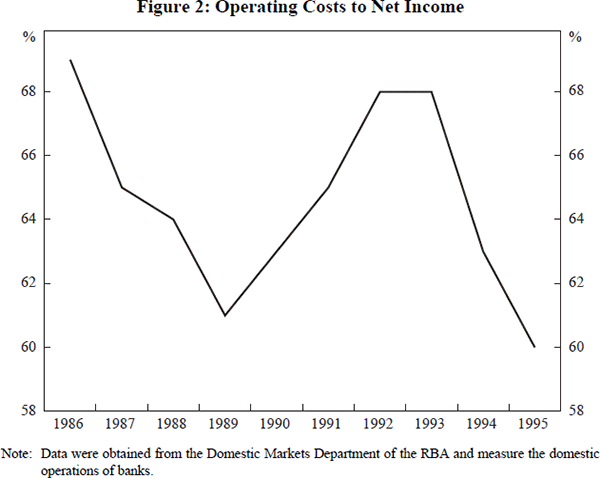
The more often-quoted measure of efficiency calculates the ratio of operating costs (excluding provisions for bad debts) to average assets. This ratio has fallen 15.2 per cent since 1986 (Figure 3).
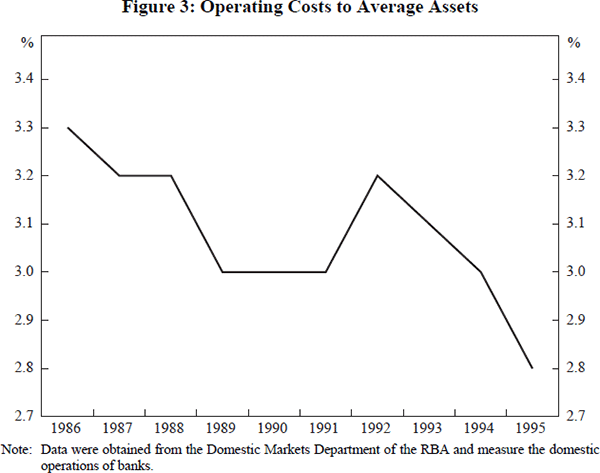
While international comparisons are particularly hampered by data inconsistencies, it is useful to at least attempt to ascertain how Australia's situation relates to that of other OECD countries (Figure 4).[1] Between the late 1980s and early 1990s, 11 of these 21 OECD countries experienced a fall in their ratio of operating expenses to average assets. Australia was one of those 11 countries. However, at 2.93 per cent, we remained above (although only slightly) the early 1990s sample average of 2.83 per cent. But a number of provisos need to be made when using this measure to make international comparisons of Australian banks' productivity:
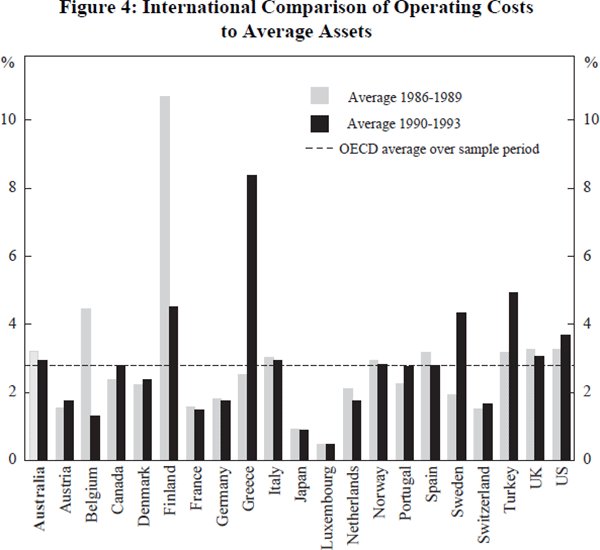
- Compositional shifts in banks' business can be expected to decrease the costs to average assets ratio without any increase in the efficiency of their individual operations. This influence may be significant because financial deregulation was associated with market liberalisation and the outward orientation of the Australian economy. As a consequence, there was substantial growth in banks' corporate and offshore activities, which command little payments system obligations.
- Banks' consolidated accounts data include their overseas operations and, thereby, can be distorted by acquisitions and mergers, especially if the overseas acquisitions have significantly different cost structures to the bank's domestic operations (Phelps 1991).
Overall, and despite their problems, the above ‘input’ measures are generally indicative of increasing efficiency and, therefore, of possibly rising productivity in the Australian banking sector over the period from the mid 1980s.
3.2 Output Efficiency
We now turn to some measures of banks' efficiency in pricing and achieving levels of output. Banks can charge their customers fees for services, can attempt to recoup their costs by charging a higher interest margin or, as is more likely, they can use some combination of fee charges and interest income. Compared with a range of OECD countries, Australian banks' reliance on service fees is relatively low, as shown in Figure 5. This figure is based on consumer market research – undertaken by NAB – which shows that a major barrier to more efficient pricing is the continued high aversion to fees in the consumer and business market. (The UK recovers almost none of its costs with fees. In its case, costs are recovered by wide interest rate spreads on transaction accounts.) This implied cross-subsidisation of services from interest rate margins, rather than the more comprehensive use of banking service fees (which would be more in accordance with the principals of ‘user-pays’ and marginal-cost pricing), implies an allocative output inefficiency in the banking system.
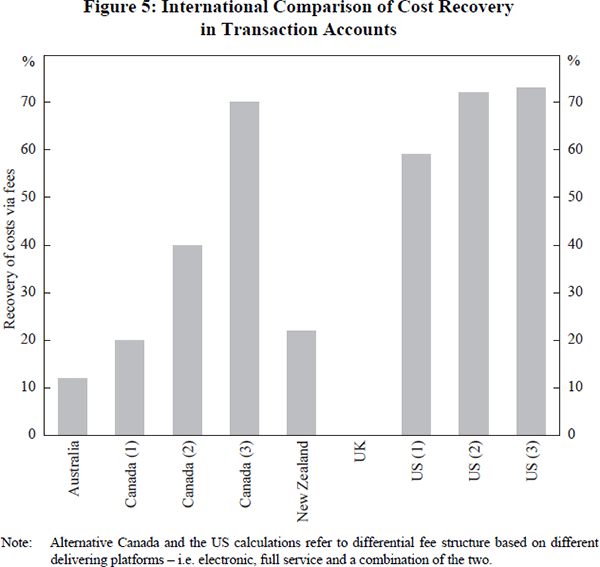
Complementing fee comparisons, then, the average interest spread can be used as another general efficiency measure. It is here calculated as the ratio of banks' net interest income to average assets (Figure 6). Once again, 11 countries in this sample (of which Australia is one) experienced a fall in this ratio between the late 1980s and the early 1990s. Only slightly below the sample average over the first period, Australia's ratio fell to 2.49 per cent in the second period to be well below that sample average of 2.96 per cent. It should also be noted that Australian banks' net interest income tends to be biased upwards by the treatment of bills (see RBA (1994)) and, furthermore, that Australian financial institutions typically rely more heavily on interest rather than fee income, implying that this measure may overstate Australian banks' efficiency. In this way, the net interest income to average assets ratio, like its complementary costs measure, provides some contradictory evidence. That said, in Australia there has been some, albeit minor, downward movement of margins.
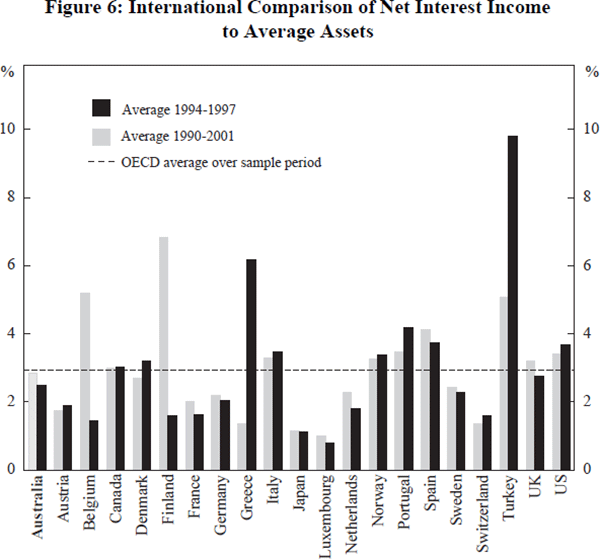
Measures of technical output efficiency include estimates of banks' scale efficiency. Scale efficiency refers to banks or branches achieving an optimum size for producing financial services and thereby, ensuring operation at the minimum point of the average cost curve. Figure 7 shows that in the late 1980s, for NAB, there appears to be a negative relationship between branch size and branch efficiency. The strategy adopted by the NAB was to re-engineer its processes (through identifying key business activities that can either be streamlined or eliminated), upskilling its labour force and increasing the use of technology. Over time, the net effect of these initiatives has resulted in significant improvements in branch efficiency and elimination of the apparently negative relationship between branch size and efficiency.
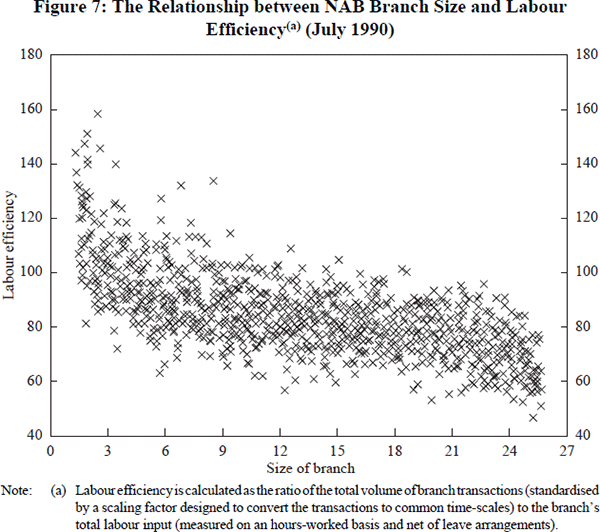
As well, the increased competition resulting from financial deregulation may continue to provide impetus for the achievement of further technical output efficiencies through scope economies. Economies of scope are achieved when a bank recognises that the cost of producing a range of outputs is less than the cost of producing them independently.
Finally, banks' profitability is often highlighted in discussions of how to measure the sector's productivity. Measured here as the rate of return on shareholders' funds, the gap between banks' profitability (Figure 8) and that of other companies has progressively been reduced. At one level, this in part reflects relatively flat margins, notwithstanding increased cost of funds to the banking sector. More fundamentally it reflects the importance of competitive forces. Indeed, expectations are that the gap of the 1980s (and earlier periods) will not re-emerge. While no definitive conclusions can be drawn from the closing of the gap, it does support the view that increased competition has delivered efficiency gains since the early 1980s.
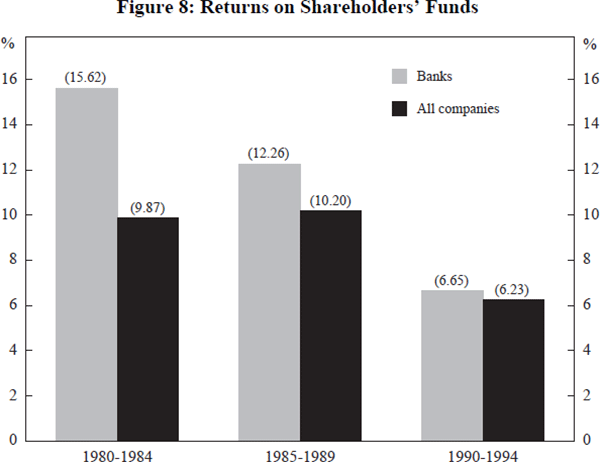
3.3 Other Indicators of Productivity
A broadly-equivalent measure of labour productivity is ‘net value added’, estimated here as the ratio of NAB's net earnings to total personnel costs. This measure shows the contribution of labour to the net earnings of the bank (Figure 9) and has been improving since the early 1990s.

Disaggregating these data into household and business markets implies that NAB has achieved productivity gains in both areas (Figure 10).[2]

Assuming that these National Australia Bank results are indicative of the banking sector as a whole, productivity once again appears to be improving in the 1990s.
3.4 Technology and Total-Factor Productivity
Technical progress is often referred to as total-factor productivity (TFP). A characteristic of the banking sector is its preponderance of new technology. This has been manifested in ATMs and credit cards, and more recently, the widespread installation of EFTPOS and the introduction of debit and smart cards. This type of technological innovation can be described as capital enhancing (or Solow neutral).[3] To the extent that technical progress augments banks' effective capital stock, this leads to an increase in the marginal product of labour. If labour is being paid the value of its marginal product, and the banking industry is competitive, then employment in the industry expands to equilibrate the marginal product of labour in banking to the economy-wide wage rate. Thus, measures of bank efficiency based on employed labour may be misleading. As well, technological innovation often leads to quality enhancement. And this highlights a further problem inherent in any attempt to gauge banking sector productivity – adjusting the measure of bank output for changes in quality becomes virtually impossible when the very nature of that output remains vague.
The sort of capital-enhancing innovation found in banking has another important implication – one that fits neatly with endogenous growth. Knowledge is created as a by-product of a physical investment process so that there is a public good aspect to that investment. Consequently, investment decisions by a bank (or group of banks) can enhance the productivity of other financial institutions in the economy.
4. Conclusions
Given the problems associated with the construction and interpretation of much of the data on bank efficiency/productivity surveyed above, each can only be considered as tentative evidence of actual productivity performance. However, the fact that almost all of the series point in the same direction supports the hypothesis that productivity in the banking sector has been rising during the 1990s. While some confidence can be placed in this qualitative statement, it is far harder to quantify the extent of productivity growth. Indeed, the challenges witnessed to date are not likely to be diminished. Banks continually look to re-organise their processes and exploit new technology in an attempt to compete with other providers of financial services. Consequently, measurement of productivity in banking begs further research.
Footnotes
National Australia Bank. The paper has benefited from extensive suggestions by Alison Tarditi. The views expressed are those of the authors and do not necessarily reflect those of the National Australia Bank. [*]
International comparisons are problematic – the OECD collection, from which these data were drawn, contains a disclaimer that ‘… international comparisons in the field of income and expenditure accounts of banks are particularly difficult due to considerable differences in OECD countries as regards structural and regulatory features of national banking systems, accounting rules and practices, and reporting methods’. Definitions are not consistent and measurements are not standardised across countries. Most importantly for this study, data for many countries are global, rather than domestic (RBA 1994). [1]
The distinction between consumer and business markets is used here to differentiate lending by purpose – loans made for (small and large) business purposes are recorded as such; loans made for personal consumption (e.g. housing loans) are recorded as consumer lending. [2]
A Solow-neutral production function is capital augmenting: Y = (AK)α L1−α. [3]
References
Berger, A.N., W.C. Hunter and S.G. Timme (1993), ‘The Efficiency of Financial Institutions: A Review and Preview of Research, Past, Present and Future’, Journal of Banking and Finance, 17(2/3), pp. 221–249.
Evanoff, D.D. and P.R. Israilevich (1991), ‘Product Efficiency in Banking’, Federal Reserve Bank of Chicago Economic Perspectives, 15(1), pp. 11–32.
Phelps, L. (1991), ‘Competition: Profitability and Margins’, in I. Macfarlane (ed.), The Deregulation of Financial Intermediaries, Reserve Bank of Australia, Sydney, pp. 87–110.
Reserve Bank of Australia (1994), ‘International Comparisons of Bank Margins’, Submission to the House of Representatives Standing Committee on Banking, Finance and Public Administration, August.
Triplett, J.E. (1990), ‘Banking Output’, in Eatwell et al. (eds), New Palgrave Dictionary of Money and Finance, Macmillan, London, pp. 143–146.